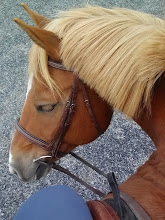Thanksgiving approaches. Family, feasts and warmth as the earth cools toward winter. We are thankful, indeed, perhaps more now than ever. And we give thanks for friendships, opportunities, learning, growth, and our teachers.
A recent discussion on the CO TH forum centered around a perennially favorite subject for bashing and praise, George Morris. It reignited in us a sense of progression of the hunter/jumper world through the past 50 years, a process which has formed the foundation of our current perspectives on horsemanship in all of its manifestations. Alluded to in an earlier post, our good fortune at being a 'fly on the wall' during the rise of the modern era of equestrian sport has allowed us to be a perpetual student! We have always soaked up any and all we can learn of horses.
George Morris is one of the truly unique individuals of sport - we don't know much about other sports, but how could he not be? From his earliest successes in the equitation ring, to Olympic heights to his commitment to preserving the classic American riding style, to his vision as chef d'equippe then on to being the most influential coach and trainer in the business, Morris has set the standard for excellence.
We riders of a certain age from the Fairfield-Westchester-New Jersey area all grew up with the same basic background, working with an interlocked group of masters and their protegees. Others, in the South, or the West, had their influences, masters in their own rights. The common thread for all was the military tradition of Ft Riley before and shortly after WWII. The cavalry system, tempered with the traditions of the European schools of France, Italy, Germany, Eastern Europe and the Iberian peninsula and Austria, produced a balanced, forward way of riding which allowed for free athletic expression form the horse, and an effective, efficient and elegant style in the rider.
The 50s saw an influx of German, Hungarian and Chekoslovakian trainers who firmly placed their stamp on our riding style. Perhaps the most influential on the showjumping world was the late Bertalan deNemethy, long time coach of the USET. His emphasis on correct gymnastics produced educated competitors and strong, sound horses. The grip-with-the-knees military style softened into one more classical, the rider appearing to be one with the horse and less defensive.
Dressage has followed a slightly different path by retreating somewhat from the freer classical art to an increasingly mechanical, technological demonstration of power, exaggerated movement and control. The 2008 Olympics in Hong Kong and the ensuing turmoil within the international governing body attests to the desire of some to move back to the more artistic expression of the horse.
Our next post will explore a bit the roots of classical horsemanship.
Have a Happy and Healthy Thanksgiving!


1 Comments:
Happy Thanksgiving :) xox
Post a Comment
Subscribe to Post Comments [Atom]
<< Home